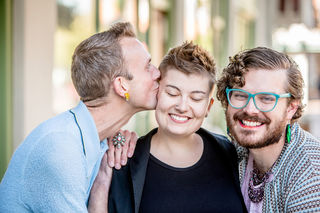Gender
A Guide to Genderqueer, Non-Binary, and Genderfluid Identity
A new gender identity is confusing to many over 30, yet critical to some youths.
Posted July 29, 2018 Reviewed by Lybi Ma

Recently, a bewildered mother wrote to me that she was confused and worried. Her daughter told her that she now identifies as genderqueer. The teenager didn't want to take masculinizing hormones or undergo body-altering surgery. What she demanded was genderless pronouns and references. Could I help her understand what was happening with her ex-daughter?
Historically, without giving it a second thought, we assumed that everyone is simply biologically male or female — though we’ve become increasingly aware that not all individuals feel that they are the gender that matches their birth sex. Within that binary mindset, we’ve also anticipated that with biological sex comes a matching gender identity, thoughts, feelings, expressions, and behaviors — though, unlike sex, to varying degrees. That is, we know that some boys feel and act more like a man than other boys; some girls feel and act more like a woman than other girls. Thinking outside those sex/gender boxes is quite daunting for some, especially in generations older than Millennials. According to the writer Urquhart, what they can’t fathom is that some individuals “feel constrained by a culture that insists that they be either male or female, with all the expectations, assumptions, and stereotypes that come along with choosing one of those identities.”
We’ve long known of the risks that children and adolescents face when they are deemed gender nonconforming by their family and peers. It’s daunting for a youth to be teased for being “gender inappropriate.” Indeed, it’s likely that the primary cause of being teased for non-straight youth is not their sexuality, but their gender expression. Hence, the mother had cause to be concerned for her genderqueer child.
Defining Genderqueer (GQ)
A GQ or nonbinary person is someone who feels that their felt gender doesn’t fit with socially constructed norms for their biological sex. This may be in terms of their thoughts, feelings, behaviors, and, most importantly, their gender identity. Although GQs vary immensely in their gender experiences and preferences, they share, according to Urquhart, “a deep, persistent unease with being associated only with the binary gender assigned to them from infancy.”
According to Richards and colleagues, GQs “have a gender which is neither male nor female and may identify as both male and female at one time, as different genders at different times, as no gender at all, or dispute the very idea of only two genders.” Fortunately for these individuals, “gender identities outside of the binary of female and male are increasingly being recognized in legal, medical and psychological systems and diagnostic classifications in line with the emerging presence and advocacy of these groups of people.” They remain, however, marginalized, at risk for victimization and discrimination.
GQ Umbrella Identities
Brace yourself, because the variety inherent among GQs has resulted in numerous additional labels within the framework of genderqueer. Here are a few of the common ones according to Giddins:
1. Genderfluid: Identify as male, female, or nonbinary at different times or circumstances
2. Third-gender: "Hijra" in India & South Asia or "Two-spirit" in Native American cultures
3. Amalgagender: Intersex people born with a mixed male/female anatomy
4. Demigender: A weak or partial connection to a certain gender (demigirl or demiboy)
5. Bigender: Having two gender identities either simultaneously or switching between the two
6. Pangender: Identifying with a vast range of different genders
7. Agender: Lacking gender, genderless, or not caring about gender identity
Urquhart added several others: trigender, neutrois, trans*, transmasculine, transfeminine, bear, butch, femme, boi, genderfree, and androgyne. Many of these are overlapping and ever-changing, which might cause, Urquhart warned, “a barrier to increased understanding and acceptance of genderqueer individuals by those on the outside” of the GQ subculture.
How does one measure GQ?
GQ seldom appears on surveys when individuals are asked about their gender. Rather, they’re to check the boy or girl box. If Hyde and her colleagues had their way, participants would be asked to report their gender identity in nonbinary ways, with options such as “female,” “male,” “transgender female,” “transgender male,” “genderqueer,” and “other.” More simply, they also could respond to an open-ended question, “What is your gender?” If they indicate a genderqueer self-label, then they could elaborate with other self-labels (noted above) that are currently used by nonbinary and gender-nonconforming persons.
Is it a category or a spectrum?
One question that baffles me is understanding if genderqueer represents a category, an identity, or a description along a spectrum between man/boy/male and woman/girl/female. Maybe it’s all three…
How many GQs are there?
This is certainly unknown, but it’s likely to be a small percentage. Several recent studies give us a slight hint. In a large Dutch sample, about 5 percent of those assigned male at birth and 3 percent of those assigned female at birth reported an “ambivalent gender identity” (an equal identification with the other sex as with the sex assigned to them at birth). About 1 percent described an “incongruent gender identity” (a stronger identification with the other sex as with the sex assigned to them at birth). How many of these individuals identify as GQ is unknown, but clearly these are upper limit rates. In a Flemish sample, the prevalence of “gender ambivalence” or nonbinary gender was twice as high in those born female (4 percent) as born male.
Are there sex differences?
Although my sense is that far more natal females than males identify as GQ, these two studies give conflicting answers. The seeming dominance of females may be because most of the visible GQs were born female.
Bottom Line
Although we might not understand GQs, listening to their experiences of gender and supporting their decision to identify as genderqueer are no-brainers. Most GQs are forgiving if we slip by using an inappropriate pronoun, especially if we offer an apology. I agree with Urquhart, accepting GQs for who they are doesn’t mean we have to give up our own binary sex/gender world; it just means that we shouldn’t impose it on everyone. We might learn something about that world to hear from those for whom standard sexual and gender categories don’t work.
References
Giddins, K. (May 16, 2018). What does non-binary mean and how does identifying as genderqueer differ from agender or genderfluid? https://www.thesun.co.uk/fabulous/6229054/non-binary-genderqueer-identi…
Hyde, J. S., Bigler, R. S., Joel, D., Tate, C. C., & van Anders, S. M. (July 19, 2018). The future of sex and gender in psychology: Five challenges to the gender binary. American Psychologist. doi: 10.1037/amp0000307
Pollard, A. (May 25, 2015). How pop is starting a genderqueer dialogue.. http://www.dazeddigital.com/music/article/24824/1/how-pop-is-starting-a…
Richards, C., Bouman, W. P., Seal, L., Barker, M. J., Nieder, T. O., & T’Sjoen, G. (2016). Non-binary or genderqueer genders. International Review of Psychiatry, 28, 95-102. doi: 10.3109/09540261.2015.1106446
Urquhart, E. (March 24, 2015). What the heck is genderqueer? http://www.slate.com/blogs/outward/2015/03/24/genderqueer_what_does_it_…




